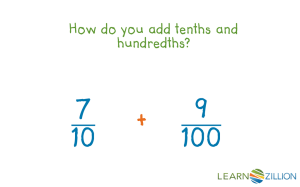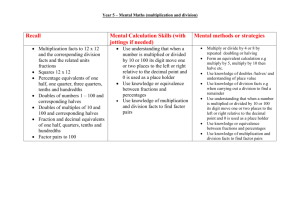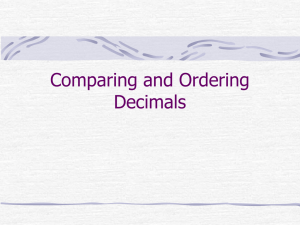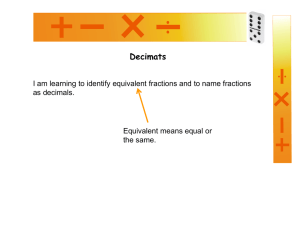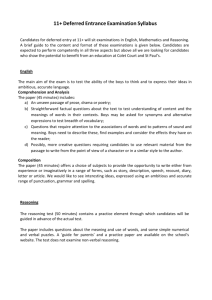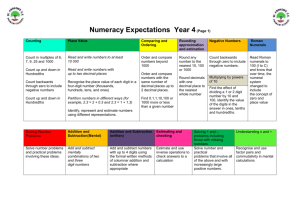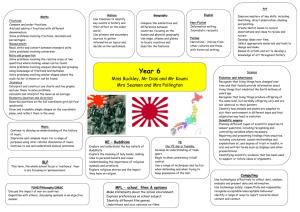Year 4 maths - Light Oaks Junior School
advertisement
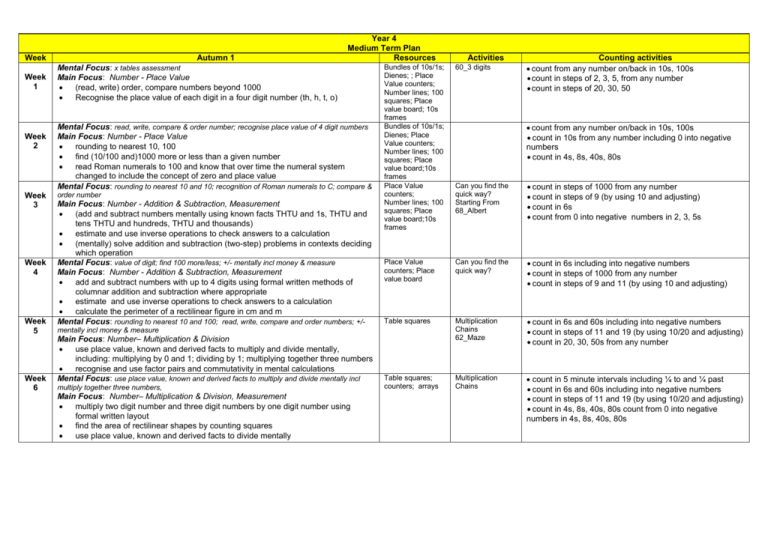
Week Week 1 Week 2 Week 3 Week 4 Week 5 Week 6 Autumn 1 Mental Focus: x tables assessment Main Focus: Number - Place Value (read, write) order, compare numbers beyond 1000 Recognise the place value of each digit in a four digit number (th, h, t, o) Year 4 Medium Term Plan Resources Mental Focus: read, write, compare & order number; recognise place value of 4 digit numbers Main Focus: Number - Place Value rounding to nearest 10, 100 find (10/100 and)1000 more or less than a given number read Roman numerals to 100 and know that over time the numeral system changed to include the concept of zero and place value Mental Focus: rounding to nearest 10 and 10; recognition of Roman numerals to C; compare & order number Main Focus: Number - Addition & Subtraction, Measurement (add and subtract numbers mentally using known facts THTU and 1s, THTU and tens THTU and hundreds, THTU and thousands) estimate and use inverse operations to check answers to a calculation (mentally) solve addition and subtraction (two-step) problems in contexts deciding which operation Mental Focus: value of digit; find 100 more/less; +/- mentally incl money & measure Main Focus: Number - Addition & Subtraction, Measurement add and subtract numbers with up to 4 digits using formal written methods of columnar addition and subtraction where appropriate estimate and use inverse operations to check answers to a calculation calculate the perimeter of a rectilinear figure in cm and m Mental Focus: rounding to nearest 10 and 100; read, write, compare and order numbers; +/- multiply together three numbers, Main Focus: Number– Multiplication & Division, Measurement multiply two digit number and three digit numbers by one digit number using formal written layout find the area of rectilinear shapes by counting squares use place value, known and derived facts to divide mentally Counting activities count from any number on/back in 10s, 100s count in steps of 2, 3, 5, from any number count in steps of 20, 30, 50 60_3 digits Can you find the quick way? Starting From 68_Albert count in steps of 1000 from any number count in steps of 9 (by using 10 and adjusting) count in 6s count from 0 into negative numbers in 2, 3, 5s Place Value counters; Place value board Can you find the quick way? count in 6s including into negative numbers count in steps of 1000 from any number count in steps of 9 and 11 (by using 10 and adjusting) Table squares Multiplication Chains 62_Maze count in 6s and 60s including into negative numbers count in steps of 11 and 19 (by using 10/20 and adjusting) count in 20, 30, 50s from any number Table squares; counters; arrays Multiplication Chains count in 5 minute intervals including ¼ to and ¼ past count in 6s and 60s including into negative numbers count in steps of 11 and 19 (by using 10/20 and adjusting) count in 4s, 8s, 40s, 80s count from 0 into negative numbers in 4s, 8s, 40s, 80s mentally incl money & measure Main Focus: Number– Multiplication & Division use place value, known and derived facts to multiply and divide mentally, including: multiplying by 0 and 1; dividing by 1; multiplying together three numbers recognise and use factor pairs and commutativity in mental calculations Mental Focus: use place value, known and derived facts to multiply and divide mentally incl Activities Bundles of 10s/1s; Dienes; ; Place Value counters; Number lines; 100 squares; Place value board; 10s frames Bundles of 10s/1s; Dienes; Place Value counters; Number lines; 100 squares; Place value board;10s frames Place Value counters; Number lines; 100 squares; Place value board;10s frames count from any number on/back in 10s, 100s count in 10s from any number including 0 into negative numbers count in 4s, 8s, 40s, 80s Autumn 2 Week Mental Focus: x tables assessment Year 4 Medium Term Plan Resources Bundles of Activities Counting activities count in steps of 7 7 Week 8 Week 9 Week 10 Week 11 Week 12 Main Focus: Number - Place Value (read, write) order, compare numbers beyond 1000 recognise the place value of each digit in a four digit number (th, h, t, o) rounding to nearest 10, 100 and 1000 read Roman numerals to 100 solve number and practical problems that involve all of the above and with increasingly large positive numbers Mental Focus: mental +/-/x/÷; rounding to nearest 10,100,1000; find 1000 more/less; area Main Focus: Number- Problem Solving solve addition and subtraction single-step problems in contexts, deciding which operations and methods to use and why. solve problems involving multiplying and adding, including using the distributive law to multiply two digit numbers by one digit Mental Focus: mental +/-/x/÷; order & compare No.s >1000; perimeter Main Focus: Number- Problem Solving solve addition and subtraction two-step problems in contexts, deciding which operations and methods to use and why. solve problems involving multiplying and adding, including using the distributive law to multiply two digit numbers by one digit, integer scaling problems Mental Focus: read, write, order & compare No.s >1000; recognise the value of digits in 4digit numbers; estimate and use the inverse to check calculations Main Focus: Number- Fractions recognise and show, using diagrams, families of common equivalent fractions add and subtract fractions with the same denominator Mental Focus: halve/double & relate x & ÷ by 2; equivalent fractions; Roman numerals to C Main Focus: Number- Fractions recognise that hundredths arise when dividing an object by one hundred and dividing tenths by ten recognise and write decimal equivalents of any number of tenths or hundredths recognise and write decimal equivalents to ½ ¼ ¾ Mental Focus: decimal equivalents of tenths or hundredths and ½ ¼ ¾; halve/double & relate x & ÷ by 2; properties of 2D shapes Main Focus: Geometry – Properties of shape compare and classify geometric shapes, including quadrilaterals and triangles, based on their properties and sizes identify lines of symmetry in 2-D shapes presented in different orientations complete a simple symmetric figure with respect to a specific line of symmetry. 10s/1s; Dienes; Place Value counters; Number lines; 100 squares; Place value board;10s frames Place Value counters; Place value board ;Table squares; counters; arrays Place Value counters; Place value board; Table squares; counters; arrays Fraction walls; Table squares; counters; count in 10s from any number including 0 into negative numbers count from any number in 100s, 1000s Can you find the quick way? Multiplication Chains count in steps of 7 and 70s count from 0 in multiples of 4, 8, 50 and 100 count in steps of 9 and 11 (by using 10 and adjusting) Can you find the quick way? Multiplication Chains count in steps of 7 and 70s including into negative numbers count in steps of 20, 30, 50 from any number including 0 count in steps of 19 and 21 (by using 20 and adjusting) count in 6s and 7s including into negative numbers count in halves, quarters and tenths count in 5 minute intervals including ¼ to and ¼ past Fraction walls; Table squares; counters; Dienes count in 6s, 60s, 7s, 70s including into negative numbers count in halves, quarters and tenths count in tenths and link to 0.1s 2D shapes; mirrors; tracing paper count in 6s, 60s, 7s, 70s including into negative numbers count in tenths linked to 0.1 then 0.2 linked to x2 count in hundredths linked to 0.01 Week Week Spring 1 Mental Focus: x tables assessment Main Focus: Measure – Time Year 4 Medium Term Plan Resources clocks Activities Counting activities count in steps of 9 count in 5 minute intervals including ¼ to and ¼ past 13 read, write and convert time between analogue and digital 12- and 24-hour clocks solve problems involving converting from hours to minutes read Roman numerals to 100 Mental Focus: recognise equivalent fractions – simplify using factors/multiple; properties of Week 14 shape; read, write & convert time between analogue & digital 12/24hr clock Week 15 factors/multiple; order and compare numbers Week 16 Week 17 Week 18 Main Focus: Number - Fractions (understand the relation between non-unit fractions and multiplication and division of quantities – find fractions of amounts) solve problems involving increasingly harder fractions to calculate quantities, and fractions to divide quantities, incl non-unit fractions where answer is a whole number Mental Focus: find fractions of amounts; recognise equivalent fractions – simplify using Main Focus: Number - Fractions find the effect of dividing a one- or two-digit number by 10 and 100, identifying the value of the digits in the answer as ones, tenths and hundredths compare numbers with the same number of decimal places up to two decimal places round decimals with one decimal place to the nearest whole number Mental Focus: perimeter; x/÷ by 10 and 100 identifying value of digits; read, write & convert time between analogue & digital 12/24hr clock Main Focus: Measure Convert between different units of measure [for example, km to m; hour to minute] measure the perimeter of a rectilinear figure (including squares) in cm and m estimate, compare and calculate different measures Mental Focus:, fractions of amounts; Roman numerals to C, convert units of measure Main Focus: Number – Problem Solving solve addition and subtraction two-step problems in contexts, deciding which operations and methods to use and why solve problems involving multiplying and adding, including using the distributive law to multiply two digit numbers by one digit, integer scaling problems and harder correspondence problems such as n objects are connected to m objects. Mental Focus: x/÷ by 10/100; identify value of digits, recognise equivalent fractions – simplify using factors/multiples; read, write & convert time on analogue & digital 12/24hr clock Main Focus: Number – Problem Solving : place value & fractions; Measure solve simple measure and money problems involving fractions/decimals to two dp count in 30s and 60s relate to ½ and 1 hour Fraction walls; Table squares; counters; Dienes Relating fractions to division count in steps of 9 and 90s count in halves, quarters and tenths count in tenths and hundredths and link to 0.1s and 0.01 Fraction walls; Table squares; counters; Dienes; Place value board count in steps of 9 and 90s including into negative numbers count in steps 0.2, 0.3 and 0.5 link to x2, x3, x5 and x20, x30, x50 count in halves, quarters and tenths count in tenths and hundredths and link to 0.1s and 0.01 Place value board; rulers; metre rules; tape measures; capacity and mass equip Place Value counters; Place value board; Table squares; counters; arrays count in 6s,7s, 9s including into negative numbers count in 25s and 250s and link to ¼ measures count in 5 minute intervals including ¼ to and ¼ past Coins; Place Value counters; Place value board; Table squares Multiplication Chains Numbers Rule count in 60s, 70s, 9s, 90s including into negative numbers count in 4s, 40s, 8s, 80s count in steps of 20, 30, 50 from any number count in 1000s count in 60s, 70s, 9s, 90s including into negative numbers count in steps of 9, 11, 19 and 21 (by using 10/20 and adjusting) count in 5 minute intervals including ¼ to and ¼ past Week Spring 2 Year 4 Medium Term Plan Resources Activities Counting activities Week 19 Mental Focus: x tables assessment Main Focus: Number – Place Value and + - x ÷ solve number and practical problems that involve: reading, writing, comparing, ordering, rounding with increasingly large positive numbers and negative numbers (add and subtract numbers mentally using known facts THTU and 1s, THTU and tens THTU and hundreds, THTU and thousands) identify, represent and estimate numbers using different representations use place value, known and derived facts to multiply and divide mentally, including: multiplying by 0 and 1; dividing by 1; multiplying together three numbers find the area of rectilinear shapes by counting squares estimate and use inverse operations to check answers to a calculation (mentally) solve addition and subtraction (two-step) problems in contexts deciding which operation Mental Focus: order& compare numbers beyond 1000; identify , represent and estimate Week 20 numbers using different representations; x/÷ 10 and 100 Week 21 halving & doubling Week 22 Main Focus: Measurement - Time read, write and convert time between analogue and digital 12- and 24-hour clocks solve problems involving converting from hours to minutes read Roman numerals to 100 solve problems involving converting from hours to minutes; minutes to seconds; years to months; weeks to days. Mental Focus: rounding to nearest 1, 10 and 10; recognition of Roman numerals to C; Main Focus: Measurement Convert between different units of measure [for example, kilometre to metre; hour to minute] measure and calculate the perimeter of a rectilinear figure (including squares) in centimetres and metres estimate, compare and calculate different measures, including money in pounds and pence Mental Focus: convert units of measure; read, write & convert time on analogue & digital 12/24hr clock; x/÷ 10 and 100 Main Focus: Geometry- Properties of Shape compare and classify geometric shapes, including quadrilaterals and triangles, based on their properties and sizes identify acute and obtuse angles and compare and order angles up to two right angles by size Place Value counters; Place value board; Table squares; counters; arrays Can you find the quick way? Middle Points 1* count in steps of 11 count in steps 0.2, 0.3 and 0.5 link to x2, x3, x5 and x20, x30, x50 count in halves, quarters and tenths count in tenths and hundredths and link to 0.1s and 0.01 Venn diagram multiples What are my No.s? Clocks; stop watches; calendars count in steps of 11 and 110s count in 7s and link to days in a week count in 5 minute intervals including ¼ to and ¼ past count in 30s and 60s relate to ½ and 1 hour, secs in a minute Coins; Place value board; rulers; metre rules; tape measures; capacity and mass equip count in steps of 11 and 110s including into negative numbers count in 25s, 50s and 250s, 500s and link to ¼ and ½ measures count in 1000s count in tenths and hundredths and link to 0.1s and 0.01 and measure Simple angle measurer; 2D shapes count in 6s,7s,11s including into negative numbers count in 90s link to angles/turns count in 5 minute intervals including ¼ to and ¼ past count in halves, quarters and tenths Week 23 Mental Focus: properties of shape; types of angle; represent and estimate numbers using 2d shapes count in 60s, 70s, 90s, 11, 110s including into negative numbers count in 4s, 40s, 8s, 80s count in steps of 20, 30, 50 from any number count in 0.2, 0.3, 0.4, 0.8s Graph paper count in 60s, 70s, 90s, 11, 110s including into negative numbers count in steps of 9, 11, 19 and 21 (by using 10/20 and adjusting) count in 5 minute intervals including ¼ to and ¼ past count in halves, quarters, tenths and hundredths different representations Main Focus: Geometry- Position and Direction describe positions on a 2-D grid as coordinates in the first quadrant describe movements between positions as translations of a given unit to the left/right and up/down plot specified points and draw sides to complete a given polygon. Week 24 Mental Focus: order& compare numbers beyond 1000; find fractions of amounts; halving & doubling Main Focus: Statistics interpret and present discrete and continuous data using appropriate graphical methods, including bar charts and time graphs. Year 4 Medium term Plan Week Summer 1 Resources Activities Counting activities Mental Focus: x tables assessment Week Main Focus: Statistics solve comparison, sum and difference problems using information presented in bar 25 charts, pictograms, tables and other graphs. Mental Focus: find 1000 more/less; recognise the value of digits in 4digit numbers; order and Week 26 compare numbers Week 27 estimate numbers using different representations Main Focus: Number – Fractions recognise and show, using diagrams, families of common equivalent fractions add and subtract fractions with the same denominator solve problems involving increasingly harder fractions to calculate quantities, & fractions to divide quantities, incl non-unit fractions where answer is whole number Mental Focus: recognise equivalent fractions; find fractions of amounts; identify, represent and Main Focus: Number – Fractions recognise that hundredths arise when ÷ an object by 100 and dividing tenths by 10 recognise and write decimal equivalents of any number of tenths or hundredths recognise and write decimal equivalents to ½ ¼ ¾ find the effect of ÷a 1 or 2-digit number by 10 and 100, identifying the value of the digits in the answer as ones, tenths and hundredths compare numbers with the same number of decimal places up to two dps round decimals with one decimal place to the nearest whole number Week Mental Focus: read Roman numerals to C; round to nearest 1, 10,100; x/÷ by 10 and 100 Main Focus: Measure - Time 28 read, write and convert time between analogue and digital 12- and 24-hour clocks solve problems involving converting from hrs-mins; mins-secs; yrs-mths; wks-days. Week Mental Focus: double and halve; perimeter; convert units of measure incl time Main Focus: Number – Place Value 29 order, compare numbers beyond 1000 & recognise the place value of each digit rounding to nearest 10, 100 find (10/100 and)1000 more or less than a given number read Roman numerals to 100 and know that over time the numeral system changed identify, represent and estimate numbers using different representations Week Mental Focus: properties of shape; types of angle; area Main Focus: Problem Solving 30 solve + and - two-step problems in contexts - which operations & methods & why solve problems involving x and +, incl using distributive law to x 2digit numbers by 1 digit, integer scaling problems & harder correspondence problems solve simple measure and money problems involving fractions/decimals to two dp Fraction walls; Table squares; counters; Dienes; Place value board Fraction Chain Fraction Grid count in steps of 12 count in steps 0.2, 0.3 and 0.5 link to x2, x3, x5 and x20, x30, x50 count in halves, quarters and tenths count in tenths and hundredths and link to 0.1s and 0.01 count in steps of 12 and 120s count in 5 minute intervals including ¼ to and ¼ past count in halves, quarters and tenths count in tenths and hundredths and link to 0.1s and 0.01 Fraction walls; Table squares; counters; Dienes; Place value board count in steps of 12 and 120s including into negative numbers count in 25s, 50s and 250s, 500s and link to ¼ and ½ measures count in 1000s count in tenths and hundredths and link to 0.1s and 0.01 and measure Clocks; stop watches; calendars count in 6s,8s, 11s and 12s including into negative numbers count in 7s and link to days in a week count in 5 minute intervals including ¼ to and ¼ past count in 30s and 60s relate to ½ and 1 hour, secs in a minute count in 60s, 70s, 90s, 110s, 12s including into negative numbers count in 4s, 40s, 8s, 80s,0.4s, 0.8s count in steps of 20, 30, 50 from any number Dienes; Place Value counters; Number lines; 100 squares; Place value board; 10s frames Coins; Place Value counters; Place value board; Table squares Middle Points One Star Multiplication Chains Multiplication Arithmogons Sums Diffs & Products count in 60s, 70s, 90s, 11s, 12s, 120s including into negative numbers count in steps of 9, 11, 19 and 21 (by using 10/20 and adjusting) count in 5 minute intervals including ¼ to and ¼ past count in halves, quarters, tenths and hundredths Week Summer 2 Year 4 Medium term Plan Resources Activities Counting activities Week 31 Week 32 Week 33 Week 34 Mental Focus: x tables assessment Main Focus: Geometry compare and classify geometric shapes, including quadrilaterals and triangles, based on their properties and sizes identify lines of symmetry in 2-D shapes presented in different orientations complete a simple symmetric figure with respect to a specific line of symmetry. identify acute and obtuse angles and compare and order angles up to two right angles by size describe positions on a 2-D grid as coordinates in the first quadrant describe movements between positions as translations of a given unit to the left/right and up/down plot specified points and draw sides to complete a given polygon. Mental Focus: read, write, order and compare numbers; mentally +, , x, ÷; x ÷ by 10/100 Main Focus: Measurement convert between different units of measure [for example, kilometre to metre; hour to minute] measure and calculate the perimeter of a rectilinear figure (including squares) in centimetres and metres find the area of rectilinear shapes by counting squares estimate, compare and calculate different measures, including money in pounds and pence read, write and convert time between analogue and digital 12- and 24-hour clocks solve problems involving converting from hours to minutes; minutes to seconds; years to months; weeks to days. Mental Focus: read, write & convert time on analogue & digital 12/24hr clock; perimeter; properties of shape Main Focus: Problem Solving solve addition and subtraction two-step problems in contexts, deciding which operations and methods to use and why solve problems involving multiplying and adding, including using the distributive law to multiply two digit numbers by one digit, integer scaling problems and harder correspondence problems such as n objects are connected to m objects solve simple measure and money problems involving fractions/decimals to two dp solve problems involving increasingly harder fractions to calculate quantities, and fractions to divide quantities, including non-unit fractions where the answer is a whole number solve number and practical problems that involve: reading, writing, comparing, ordering, rounding with increasingly large positive numbers and negative numbers Revision for Optional SATs Assessment Week count from 0 in multiples up to 12 x 12 2D shapes; mirrors; tracing paper; simple angle measurer count in 90s link to angles/turns count in 5 minute intervals including ¼ to and ¼ past count in halves, quarters, tenths and hundredths Place value board; rulers; metre rules; tape measures; capacity and mass equip; clocks; coins; stop watches; calendars What else do I know? count from 0 in multiples up to 12 x 12 Place Value counters & board; Number lines; 100 squares; tables squares; coins; clocks Multiplication Chains Fraction Chain Fraction Grid Sums Diffs & Products count from 0 in multiples up to 12 x 12 count in 5 minute intervals including ¼ to and ¼ past count in 30s and 60s relate to ½ and 1 hour, secs in a minute count in 25s, 50s and 250s, 500s and link to ¼ and ½ measures count in 1000s count in steps 0.2, 0.3 and 0.5 link to x2, x3, x5 and x20, x30, x50 count in halves, quarters and tenths count in tenths and hundredths and link to 0.1s and 0.01 Week 35 Mental Focus: find 1000 more/less; Roman numerals to C; area; equivalent fractions Main Focus: Statistics interpret and present discrete and continuous data using appropriate graphical methods, including bar charts and time graphs. solve comparison, sum and difference problems using information presented in bar charts, pictograms, tables and other graphs. Mental Focus: read, write, order, compare numbers to at least 1000; value of digits in 4 digit numbers and to 2dp; x/ Week 36 10/100 Main Focus: Number - + - x ÷ Problem Solving solve addition and subtraction two-step problems in contexts, deciding which operations and methods to use and why solve problems involving multiplying and adding, including using the distributive law to multiply two digit numbers by one digit, integer scaling problems and harder correspondence problems such as n objects are connected to m objects solve simple measure and money problems involving fractions/decimals to two dp solve number and practical problems that involve: reading, writing, comparing, ordering, rounding with increasingly large positive numbers and negative numbers count from 0 in multiples up to 12 x 12 Graph paper count in steps of 9, 11, 19 and 21 (by using 10/20 and adjusting) count in 5 minute intervals including ¼ to and ¼ past count in halves, quarters, tenths and hundredths Place Value counters & board; Number lines; 100 squares; tables squares; coins; clocks Can you find the quick way? Multiplication Chains Sums Diffs & Products count from 0 in multiples up to 12 x 12 count in halves, quarters and tenths count in tenths and hundredths and link to 0.1s and 0.01 count in 5 minute intervals including ¼ to and ¼ past

